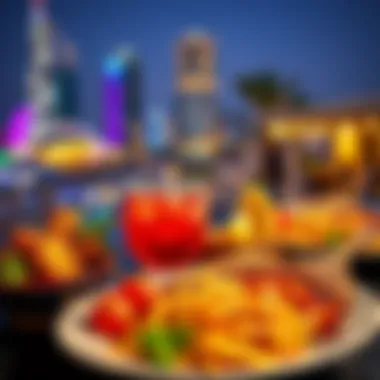Exploring the Culinary Art of Warqa in Middle Eastern Cuisine


Intro
In the bustling culinary scene of the Middle East, warqa stands out as a traditional pastry embraced by both locals and visitors. Its delicate layers, often compared to phyllo dough, may seem simple at first glance, but the craftsmanship behind creating warqa is nothing short of an art form. This pastry has been serving up stories, traditions, and flavors that trace back to the heart of Middle Eastern culture.
From lavish feasts to casual street snacks, warqa has carved its niche in the dining experiences across Dubai, demonstrating its timeless relevance. Its ability to adapt and integrate into contemporary gastronomy only deepens its cultural significance. But what exactly makes warqa so captivating? This journey into the world of warqa will take us through its rich history, culinary techniques, and the modern flair it brings to Dubai's dining table.
This exploration will offer a closer look at:
- The historical roots of warqa and its evolution over time.
- Culinary techniques that elevate warqa, showcasing both traditional and modern methods.
- The cultural importance of this pastry in Middle Eastern festivities and daily life.
- Recommended pairings that complement the unique flavors of warqa, enhancing the overall dining experience.
By delving into these aspects, we aim to equip readers with a comprehensive understanding of warqa and its role in the vibrant culinary tapestry of the region.
Understanding Warqa
In the realm of Middle Eastern cuisine, warqa stands out not only as a pastry but as a testament to cultural heritage. To truly appreciate warqa, one needs to dissect its significance beyond the surface. At its core, understanding warqa involves recognizing its rich historical lineage and the culinary traditions that have evolved alongside it. This journey is essential for expatriates, tourists, locals, and real estate agents who wish to delve deeper into the luxurious layers of dining experiences in this vibrant region.
Definition and Origin
Warqa, often translated as "paper" in Arabic, refers to delicate pastry sheets that have a unique texture and versatility. Traditionally, it is made with wheat flour and water, rolled out until it's nearly translucent—much like the skin of a dumpling. The origin of warqa can be traced back to the age-old culinary practices of North Africa and the Middle East, where it played an integral role in festive dishes and celebrations. The technique of making warqa has been passed down through generations, each family infusing their own flair while adhering to age-old methods. Should one wish to uncover deeper historical nuances, references can be found in texts detailing the evolution of Arabic gastronomy, such as those on Britannica.com.
Culinary Traditions
The culinary journey of warqa weaves through a tapestry of traditions. From Morocco to the Levant, each region adopts warqa in its own right. In Morocco, for example, warqa is skillfully layered with aromatic fillings, such as spiced meats and nuts, often seen at grand family feasts during religious holidays like Eid. Conversely, in parts of the Levant, it may host savory vegetables or sweetened nuts, a staple in gatherings and a preferred choice during Ramadan.
In essence, warqa embodies the shared culinary heritage of the Arab world. It acts as a canvas, inviting cooks to experiment and innovate, adhering to both historical respect and modern interpretations. As each bite reveals layers of flavor, it becomes clear that warqa is much more than mere sustenance; it is a symbol of communal ties and familial bonds.
"Warqa is not just a pastry; it is a representation of generations of culinary artistry and a bridge between the past and present."
The significance of understanding warqa lies in its ability to encapsulate the identity of a region within its thin layers. For those in Dubai, where culinary landscapes are consistently evolving, gaining insight into warqa can help highlight the blend of traditional roots and contemporary cuisine, ensuring that these culinary practices remain vibrant and relevant in today's dining experience.
The Ingredients of Warqa
The foundation of any dish that seeks acclaim is its ingredients, and warqa is no exception. The experience one has while savoring this pastry begins long before it hits the table; it starts in the marketplace, under the industrious hands of farmers and producers who dedicate their craft to cultivate the best components. Warqa, known for its delicate, paper-thin nature, hinges on a few vital elements that come together harmoniously to create something truly remarkable. Each ingredient carries its weight, not just in flavor but also in culture and history.
Key Components
At its core, the ingredients that comprise warqa are textural marvels, often dictating the overall experience of the pastry. Let's break down some of the essential components:
- Flour: Traditionally, fine wheat flour serves as the backbone of warqa. The quality of the flour determines the dough’s elasticity, affecting how thinly it can be rolled out. Good flour should have a high protein content, which influences the finished product's texture.
- Water: Simple yet essential, water plays a critical role in binding the flour and ensuring the dough is workable. The purity and mineral content of the water can subtly affect the flavor and texture.
- Fats: Olive oil or melted butter is often used in either the dough or as a coating. This ingredient adds richness and a slight flavor that elevates the final result, making it both flaky and moist.
- Seasonings: Salt isn't just a flavor enhancer; it also contributes to the overall structure of the dough. Some variations might include a hint of sugar to balance the savory elements.
In a nutshell, understanding these key components allows chefs and home cooks alike to experiment and innovate within the rich landscape of warqa cuisine, offering opportunities to create their own signatures while respecting the traditional forms.
Quality and Sourcing
Sourcing ingredients for warqa is an art in itself. A successful dish does not just arise from following recipes; it demands the best quality ingredients, procured from trusted sources. Here are some crucial aspects to consider regarding quality and sourcing:
- Local vs Imported: While some tourists or expatriates might go to local markets seeking typical Middle Eastern ingredients, it’s becoming increasingly common to find specialty shops that import quality products from specific regions. Locating a good local source can often lead to discovering ingredients that tell a story of the place.
- Organic Options: Many consumers are shifting towards organic products, believing that these are not only healthier but also better for flavor. Flour sourced from organic farms, for instance, may deliver a superior taste and has become increasingly popular.
- Freshness: When dealing with perishables like fats or even add-ins like seasonal greens, freshness is key. Visiting the markets often, asking vendors about the latest shipments, and knowing which seasons yield the best produce improves the overall quality of the dish.
As one explores the culinary art of warqa, it becomes evident that the journey of sourcing quality ingredients often mirrors the traditional preparation processes. Such emphasis on the ingredients connects the eater not only with the food but also with the community and culture surrounding it.
Preparation Techniques
The preparation techniques for warqa are as vital as the ingredients themselves, shaping not only the texture and flavor of the pastry but also imparting a deep cultural significance. The art of making warqa is steeped in history, and understanding these techniques sheds light on the broader culinary traditions of the Middle East. Mastering these methods can elevate a dish, enhancing its complexity and making an ordinary meal extraordinary.
Traditional Methods
Traditionally, warqa preparation involves a meticulous process of layering dough that is incredibly thin. This requires skillful hands and a touch of patience. Abandoning modern conveniences, many chefs opt for methods passed down through generations. The process begins with crafting a dough made from flour, water, and sometimes a hint of salt. The dough is rolled out in circles until nearly transparent. This demands precision; too thick and the delicacy will lose its charm, too thin and it becomes fragile.


Once the dough is rolled, it is then gently layered, sometimes with a sprinkle of semolina or flour between layers to prevent sticking. This technique not only helps maintain the structure but also adds a subtle crunch when cooked. Traditionally, water or a light oil is brushed on the layers to enhance flavor as they are pressed together. Everything comes together in a large traditional oven, which provides precise heating, allowing warqa to puff up, creating a light, flaky texture.
In many homes, preparing warqa this way is a communal activity. Families gather to assist, weaving their own stories into the layers of the pastry. It’s not just about the final product; it’s about the shared experience, the laughter, and sometimes even the occasional mishap that gets immortalized in family lore.
Modern Innovations
As culinary landscapes evolve, modern innovations are breathing new life into warqa preparation. Chefs, while respecting traditional methods, are now experimenting with techniques that incorporate contemporary kitchen technology. For instance, some have taken to using specialized pasta machines instead of rolling by hand. This ensures an even thickness and consistency, making the process quicker and, in some cases, more efficient.
In recent times, the introduction of precision ovens allows for better control of temperature and humidity, ensuring perfect cooking conditions for warqa. Innovations also extend to experimenting with ingredients; alternative flours, such as almond or whole wheat, can be used for unique twists on the traditional approach. While these changes may seem radical, they honor the spirit of warqa – flexibility and creativity.
"The art of making warqa is about balance; between tradition and innovation lies the true essence of this pastry."
As the world becomes an even smaller place with globalization, variations are popping up in local markets around Dubai. Chefs are now catering to diverse palates by introducing flavors from Asian, African, and even South American cuisines into the classic warqa preparations, blending them in innovative ways that were impossible just a few decades ago. The evolving techniques of preparing warqa reflect not just culinary trends, but also the rich tapestry of cultural exchanges happening in urban centers today.
In summary, whether through the age-old traditions or the recent innovations, the preparation of warqa remains a reflection of creativity and skill. Each approach brings its own flavor and texture to this cherished dish, inviting cooks and diners alike to explore and celebrate its versatility across contexts.
Cultural Significance of Warqa
Warqa is not merely a delightful pastry; its cultural significance runs deep within the fabric of Middle Eastern society. More than just a treat for the palate, this unique culinary art reflects the historical narratives, social fabric, and spiritual practices of the region. The preparation and consumption of warqa embody a rich tapestry of identity and tradition, making it an essential topic of exploration for anyone interested in Middle Eastern cuisine.
The act of creating warqa is often interwoven with cultural gatherings and communal bonding, serving as a medium for storytelling and sharing. It's a pastry that links generations, connecting the past to the present and enriching the culinary landscape with its layered flavors and textures. The detailed crafting of warqa, often showcased during celebratory events, establishes an atmosphere of warmth and hospitality, embodying the very essence of Middle Eastern culture—where food is intertwined with social connection.
Warqa in Religious Practices
In many Middle Eastern cultures, warqa plays a notable role in religious practices. Its presence is often felt during significant religious holidays and events. For instance, during Ramadan, the month of fasting, warqa may feature in special feasts that break the fast at sunset. Families often gather to enjoy traditional meals that include various warqa dishes, emphasizing the importance of togetherness and sharing during this sacred time.
"The bonds of family and faith are strengthened over these culinary traditions, making warqa a symbol of both nourishment and unity."
Moreover, during Eid celebrations, the act of preparing warqa becomes more than just cooking; it transforms into a ritual steeped in spirituality. Families prepare elaborate warqa dishes that honor the occasion, signifying gratitude and the joy of giving. This dual role of warqa—both as a delicious fare and as a spiritual symbol—highlights its prominence in the religious practices of the region.
Symbolism in Festivals
Culinary traditions like warqa also possess profound symbolic meaning during various festivals across the Middle East. For instance, during national holidays or cultural festivities, the preparation and sharing of warqa can symbolize unity among the community. These events create opportunities for people to come together, fostering a sense of belonging and shared identity.
The presentation of warqa dishes in festivals often embellishes colorful displays that reflect the joy of the occasion. Families may opt for intricate designs and elaborate flavors, showcasing their culinary skills while honoring cultural heritage. Such practices not only serve to celebrate the holiday but also help in the preservation of traditional cooking methods.
Pairing Warqa
Pairing warqa is crucial in crafting a memorable culinary experience. Understanding how to match this delicate pastry with beverages and side dishes can elevate the flavors and highlight the unique characteristics of warqa itself. Each element contributes layers of taste and texture, creating a harmonious balance that excites the palate. It’s worth considering that these combinations are not mere suggestions; they reflect centuries of culinary tradition and innovation within Middle Eastern cuisine.
Beverages that Complement Warqa
Traditional Drinks
Traditional drinks often embody the essence of culture. These beverages, such as mint tea and rose water lemonade, enhance the experience of eating warqa by providing a contrast of flavors—sweetness and acidity that can cut through the richness of the pastry. Mint tea, with its refreshing aroma, brings a soothing yet invigorating element to the table. It serves not only as a palate cleanser but also carries historical significance. Traditionally served in small glasses, this drink creates a sense of community during a meal. It effectively bridges both warmth and hospitality.
Another staple could be Arabic coffee, with its strong, rich taste. This choice invites an invigorating kick while pairing nicely with both sweet and savory warqa. The unique feature of Arabic coffee is its often Cardamom-infused nature, contributing a fragrant spice that can accentuate the flavors found in the pastries. However, while traditional drinks have their merits, they may not appeal universally due to their acquired taste or levels of sweetness.
Modern Assortments
When it comes to modern assortments, creative cocktails and innovative soft drinks are becoming popular choices to pair with warqa. For instance, citrus-infused mocktails can introduce a refreshing zest, recreating a burst of brightness that contrasts with the flaky texture of warqa. These beverages harness a playful spirit while reflecting a modern twist on traditional dining.
Moreover, many establishments have embraced the craft cocktail movement, combining local fruits with spirits and promoting a sense of place through their flavors. The flexibility of modern assortments allows for greater experimentation, appealing to a diverse audience. However, it's important to note that the occasional complexity or bitterness in some cocktails may not harmonize with all types of warqa, necessitating careful selection.
Side Dishes to Enhance the Experience
Classic Accompaniments
Classic accompaniments such as hummus and tzatziki serve as ideal side dishes to enjoy with warqa. Hummus, with its smooth, creamy texture, provides a contrast that complements the crispy layers of the pastry. This blend of chickpeas, tahini, and lemon juice offers a refreshing balance, nourishing the palate with nutrients while delivering rich flavors. Tzatziki, on the other hand, with its yogurt base and fresh cucumber, adds a cooling effect, particularly beneficial when indulging in spicier variations of warqa.


These traditional dips are not just favorites due to their taste; they also play a practical role in Middle Eastern settings by increasing the quantity of the meal, making it broader and more fulfilling. They embody a comforting familiarity, often evoking nostalgia for many diners. However, some might argue that they could overshadow the specific flavors of more delicately flavored warqa.
Contemporary Pairings
Contemporary pairings are all about innovation. Modern culinary artists have started blending warqa with fusion dishes, challenging traditional pairings altogether. For example, sushi-inspired warqa showcases a blend of ingredients that typically belong on a sushi platter wrapped in the pastry’s delicate layers. This choice amplifies the creativity of dining experiences and brings a fresh perspective to how warqa can be experienced.
Such contemporary pairings often invite adventurous palates to explore new combinations of flavors, opening the door to a broader appreciation of warqa’s versatility. Nonetheless, these unique pairings might not resonate with guests expecting a traditional dining experience, as breaking with convention is not for everyone. Still, the beauty lies in the contrast and ability to surprise diners, prompting them to rethink how they enjoy this iconic pastry.
Warqa in Contemporary Dubai
In contemporary Dubai, warqa serves as more than just a traditional pastry; it embodies a unique blend of cultural heritage and modern culinary creativity. This intricate pastry, often used as a wrapping for various fillings, is gaining traction in the vibrant culinary landscape of the city. With a thriving food scene that attracts residents and tourists alike, understanding the significance of warqa in Dubai adds a rich layer to the city's gastronomic identity.
Warqa in Fine Dining
The inclusion of warqa in fine dining restaurants highlights its adaptability and appeal to a discerning palate. High-end establishments such as At.mosphere and Zuma have carefully crafted their own interpretations of this traditional pastry. At these venues, warqa is not merely a component but a canvas for elevated culinary art.
Often filled with ingredients like spiced lamb or saffron-infused vegetables, fine dining iterations of warqa prioritize presentation as much as taste. The delicate layers of warqa are showcased in exquisite plating, turning each dish into an experience devoid of ordinary plating. The flavors reflect a poise between tradition and innovation, drawing in both local patrons and tourists eager to explore Dubai’s culinary offering.
Moreover, the use of locally sourced ingredients to fill the warqa adds a sustainable touch to these dishes, marrying luxury with ethics. Chef's selections rotate seasonally, incorporating Dubai's rich produce into sumptuous creations that captivate guests. Dining experiences that feature warqa intertwine with the broader story of Dubai’s evolution as a culinary hub within the region and the world.
Street Food Variations
On the other end of the spectrum, warqa’s charm resonates through the bustling street food scene in Dubai. It provides everyday locals and visitors an opportunity to savor authentic flavors on the go. Food stalls and food trucks specialize in serving various street-food takes on warqa, often stuffed with combinations like roasted chicken with spices and herbs or sweet fillings that cater to the less savory palate.
A quintessential example of this is the popular dish called warqa bil khudar, where the pastry envelops fragrant vegetables. Street vendors often prepare this delight to order, ensuring freshness that enhances the layered texture. Here, warqa’s versatility shines bright, appealing to a broad audience.
Pricing varies, giving everyone a chance to experience this traditional delicacy without breaking the bank. As a result, the presence of warqa in this informal culinary setting fosters a sense of community, allowing strangers to share meals, stories, and traditions.
In Dubai, whether it’s at a swanky restaurant or a humble street stall, warqa stands as a testament to the ongoing evolution of food culture. It bridges the old with the new, giving everyone a taste of its rich background while simultaneously embracing the future of culinary creativity.
"Warqa is not just food; it's a narrative of cultural fusion that thrives in the heart of Dubai."
Warqa encapsulates the essence of Dubai's vibrant culinary scene. From posh dining experiences to snappy street eats, this pastry remains multifaceted, continually inviting exploration and enjoyment.
The Health Aspects of Warqa
Understanding the health aspects of warqa is crucial in today’s culinary discussions. As an emblem of Middle Eastern cuisine, it’s not just about its savory flavors but also about its nutritional contributions and dietary considerations. The art of crafting warqa, whether in sweet or savory forms, often intertwines traditional practices with modern health insights, creating a diverse array of options for consumers.
Nutritional Profile
The nutritional profile of warqa is as layered as its structure. Warqa is typically made from very thin sheets of dough, which are versatile and can cater to various fillings. Here’s a closer look at what makes up its nutritional makeup:
- Calories: Depending on the filling, the calorie count can vary significantly. For instance, a meat-filled warqa may have more calories than a sweet version stuffed with pistachio or almond.
- Carbohydrates: The dough is primarily made of wheat flour, which contributes to the carbohydrate content. This energy source is beneficial, but moderation is key for those monitoring their intake.
- Proteins: When filled with meat or legumes, warqa can serve as a good source of protein, essential for muscle repair and growth.
- Fat Content: The fat content, largely determined by the ingredients used in the filling, can vary. For healthier choices, opting for fillings with olive oil or lean meats can be beneficial.
- Vitamins and Minerals: Depending on the choice of fillings, warqa can be rich in important vitamins and minerals. For example, incorporating vegetables or nuts can enrich the dish with antioxidants and nutrients.
Overall, warqa can be enjoyable without compromising health, especially when prepared with nutritious ingredients.
Dietary Considerations
When considering dietary implications, a few factors come into play regarding warqa. It’s essential to keep the audience in mind, as habits and preferences can greatly differ among expatriates, tourists, and locals. Here are some dietary considerations to ponder:
- Allergies: Some individuals may have gluten intolerance or allergies to specific ingredients commonly used in warqa. It’s advisable to seek gluten-free alternatives when necessary, as some vendors might offer substitutes like chickpea flour.
- Dietary Restrictions: Health-conscious eaters, including vegetarians and vegans, can find ways to enjoy warqa as well. Fillings such as spinach, lentils, or mixed vegetables can make a satisfying alternative that aligns with plant-based diets.
- Portion Control: While warqa can be a delightful treat, practicing portion control is vital. It's easy to overindulge in rich flavors, especially at gatherings and festive occasions. Remember that smaller portions can still satisfy the palate.
- Sugar Content: In the case of sweet warqa, such as those with honey or sugar-laden fillings, individuals mindful of sugar intake should enjoy these sparingly, especially if they are managing conditions like diabetes.
Incorporating warqa into meals offers a journey through health-conscious choices. The balance of flavors, textures, and nutrition can appeal to a variety of palettes while keeping health considerations in check. Be it a street food variation or a gourmet experience, understanding the health aspects of warqa is pivotal in appreciating this culinary treasure.
Recipes Featuring Warqa
The creativity and versatility of warqa cannot be overstated. In this section, we dive into recipes that feature this beloved pastry, revealing its possibilities and the unique culinary experiences it can offer. Understanding how to utilize warqa in both savory and sweet dishes opens a doorway to exploring Middle Eastern cuisine in greater depth. Beyond just a cooking method, these recipes serve as a bridge connecting different cultures and culinary practices, making them relevant to expatriates, tourists, and locals alike.


Savory Preparations
When it comes to savory preparations, warqa takes on an almost magical quality. It can transform everyday ingredients into something spectacular. One notable dish is warqa stuffed with spiced meats, often flavored with herbs, nuts, and local spices. The beauty lies in the texture; the delicate sheets of warqa create a crispy exterior, encasing juicy and flavorful fillings.
A few considerations when designing savory recipes with warqa:
- Variability: You can use meat like lamb or chicken, or even opt for vegetarian options with roasted vegetables, making it accessible to various dietary preferences.
- Flavor: Bold seasonings such as cumin and coriander can elevate your warqa dish, infusing each bite with deep flavor.
- Serving Style: Presenting warqa as individual parcels adds an interesting visual appeal. Additionally, accompanying sauces like tzatziki or harissa can enhance the taste sensation.
Sweet Variations
In the realm of sweets, warqa showcases its adaptability once more. One of the traditional delights is warqa filled with sweetened nuts and honey, drizzled with a delicate syrup for an extra layer of decadence. The combination of the crispy pastry against the rich filling creates a delightful contrast.
Key points for crafting sweet dishes include:
- Interactive Ingredients: Incorporating dried fruits like apricots or dates can add natural sweetness and complexity to the dish.
- Culinary Techniques: Experimenting with different methods, like frying or baking, can yield diverse textures and flavors, further enriching the sweet offerings.
- Garnishing: A sprinkle of pistachios or coconut flakes on top can provide a pop of color and an additional textural layer.
Using warqa in both savory and sweet recipes is a testament to its versatility, turning simple ingredients into extraordinary culinary experiences for those exploring Middle Eastern cuisine.
Warqa is not just an ingredient; it’s a canvas for chefs across the globe to express their creativity. Whether presenting it in a fine dining context or a humble street food setting, the recipes allowing for its use remind us of how food mirrors cultural identity. By embracing these recipes, we take a step closer to appreciating the intricate dance of flavors in the culinary art of warqa.
Exploring Local Markets
Exploring local markets is not just about shopping; it forms the very heartbeat of culinary experiences, especially when it comes to traditional foods like warqa. Bound in history, tradition, and community interactions, local markets offer a unique window into the world of flavors and food preparation that’s been cultivated over generations. This article segment will shed light on why venturing into these markets is essential for understanding the true essence of warqa ingredients, their sourcing, and the cultural narratives woven through them.
Where to Find Warqa Ingredients
To create a truly authentic warqa dish, focusing on where to find quality ingredients is paramount. Local markets are treasure troves bustling with activity, showcasing the richness of the region’s agricultural bounty. In many Middle Eastern cities, such as Dubai, numerous markets cater specifically to culinary enthusiasts seeking fresh, local produce.
You need to consider the following:
- Souks: Traditional markets, or souks, are great places for fruits, nuts, and spices. The spice souk in Dubai is especially noted for its fragrant selection, where you can find saffron, cardamom, or even unique flavorings for warqa.
- Farms and Cooperatives: Some markets host local farmers and cooperatives, allowing direct interaction with producers. This not only guarantees freshness but often leads to storytelling about how different ingredients interplay with cultural recipes.
- Butchers and Dairies: For savory warqa, the quality of meat and dairy substances is crucial. Visiting a local butcher or dairy stall in these markets not only ensures you are getting prime ingredients but also serves to support local businesses.
“In the world of food, the journey begins, not in the kitchen, but in the market.”
Best Places to Purchase Warqa
Purchasing warqa can be a bit of a quest in itself, but there are spots renowned for their authenticity and variety. Here's where you can find the best warqa:
- Al Karama Market: With its eclectic mix of shops, Al Karama is perfect for finding ready-made or fresh warqa. Street vendors often serve it hot, wrapped around delicious fillings, giving you a taste of its potential immediately.
- Deira: This district hosts various traditional shops that often stock a range of prepared warqa options. You can find different versions - whether your preference leans toward sweet or savory.
- Local Bakeries: Many local bakeries still maintain traditional recipes passed down through generations, offering fresh warqa made daily. Here, you can witness the artisanship that goes into making this delightful pastry.
- Online Marketplaces: Although not traditional, many small businesses are now moving online. Websites dedicated to Middle Eastern foods make it easier to source specific warqa if you’re looking to recreate the experience at home.
By integrating these market visits into your culinary explorations, you not only enrich your understanding of warqa but also form connections with the community and its heritage. The art of sourcing ingredients in local markets connects you with the flavors and stories waiting to be explored and tasted.
Warqa Around the World
The exploration of warqa transcends mere culinary curiosity; it unveils the rich tapestry of cultural exchanges stirred by this delicate pastry. It embodies how a simple dish can adapt and thrive in diverse culinary landscapes, bringing forth a blend of flavors and preparation styles that span the globe. Understanding how warqa is integrated into various cultures gives insight into not only the recipe itself but the broader patterns of migration and adaptation that characterize our modern world.
Variations in Other Cultures
In many regions outside the Middle East, warqa has found a home, with local variations uniquely reflecting the flavors and traditions of different societies. These adaptations help underline warqa's versatility.
- Central Asia: In some Central Asian countries, yufka — the close relative of warqa — might be seen in dishes like manti, dumplings that are wrapped using thin dough, similar to how one would use warqa in Middle Eastern cooking.
- North Africa: Moroccan cuisine showcases warqa in the famed b’stilla, where seasoned meat, often pigeon, is delicately wrapped in layers of this pastry, illustrating a sweet and savory blend, further emphasized with a dusting of powdered sugar and cinnamon.
- Mediterranean Influence: Across the Mediterranean, particularly in Greece, you can find phyllo dough with comparable flaky characteristics. While not directly the same, phyllo forms the backbone of several pastry dishes, showcasing a shared history with warqa that links these cultures.
These variations not only illustrate how warqa adapts to local tastes but also highlight a shared historical narrative in how culinary practices transcend borders.
Global Reception and Adaptation
The international appreciation of warqa has grown, particularly in multicultural cities where different food traditions converge. In these settings, warqa becomes both a celebrated specialty and a canvas for innovation.
- Culinary Events: Food festivals and events often spotlight warqa, giving chefs a platform to experiment and showcase new dishes incorporating this pastry. From gourmet to casual dining, warqa can be spotted in many menus across continents.
- Social Media Influence: Platforms like Instagram and TikTok have been pivotal in introducing warqa to a broader audience. Many tempted food lovers often share their experiences with unique warqa dishes, from decadent desserts to savory meals, making it a viral sensation.
- Fusions and Innovations: The adaptability of warqa continues to spark creativity. Modern fusion cuisines have taken hints from this traditional pastry, leading to dishes like warqa tacos and even dessert wraps that feature unconventional fillings.
"This ability of warqa to morph while retaining its essence symbolizes the resilience of culinary heritage across the globe."
In summation, warqa's journey around the world exemplifies how food can act as a bridge between cultures. Each bite not only delights the palate but also provides a narrative of historical migrations, cultural intersections, and modern adaptations.
For those seeking to dive deeper into the realm of culinary exploration, resources like Britannica and Wikipedia provide a trove of insightful information.













